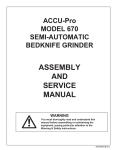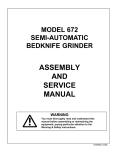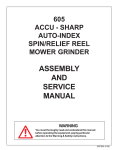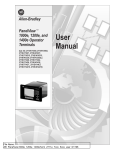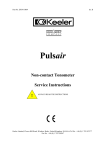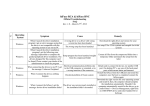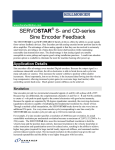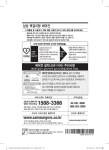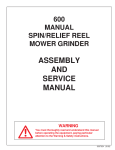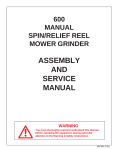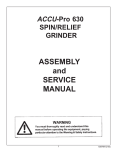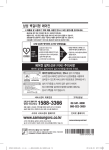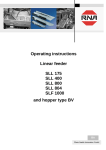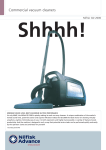Download ASSEMBLY AND SERVICE MANUAL
Transcript
ACCU-Pro MODEL 670 SEMI-AUTOMATIC BEDKNIFE GRINDER ASSEMBLY AND SERVICE MANUAL WARNING You must thoroughly read and understand this manual before assembling or maintaining the equipment, paying particular attention to the Warning & Safety instructions. 1 6707956 (12-05) SAFETY INSTRUCTIONS Safety Awareness Symbols are inserted into this manual to alert you to possible Safety Hazards. Whenever you see these symbols, follow their instructions. The Caution Symbol identifies special instructions or procedures which, if not correctly followed, could result in damage to or destruction of equipment. The Warning Symbol identifies special instructions or procedures which, if not strictly observed, could result in personal injury. 1. KEEP GUARDS IN PLACE and in working order. 12. DON'T OVERREACH. Keep proper footing and balance at all times. 2. REMOVE WRENCHES AND OTHER TOOLS. 13. MAINTAIN GRINDER WITH CARE. Follow instructions in Service Manual for lubrication and preventive maintenance. 3. KEEP WORK AREA CLEAN. 4. DON'T USE IN DANGEROUS ENVIRONMENT. Don't use Grinder in damp or wet locations. Machine is for indoor use only. Keep work area well lit. 5. KEEP ALL VISITORS AWAY. All visitors should be kept a safe distance from work area. 6. MAKE WORK AREA CHILD-PROOF with padlocks or master switches. 14. DISCONNECT POWER BEFORE SERVICING. 15. REDUCE THE RISK OF UNINTENTIONAL STARTING. Make sure the switch is OFF before plugging in the Grinder. 16. USE RECOMMENDED ACCESSORIES. Consult the manual for recommended accessories. Using improper accessories may cause risk of personal injury. 7. DON'T FORCE THE GRINDER. It will do the job 17. CHECK DAMAGED PARTS. A guard or other part that is damaged or will not perform its better and safer if used as specified in this intended function should be properly repaired or manual. replaced. 8. USE THE RIGHT TOOL. Don't force the Grinder 18. KNOW YOUR EQUIPMENT. Read this manual or an attachment to do a job for which it was not carefully. Learn its application and limitations as designed. well as specific potential hazards. 9. WEAR PROPER APPAREL. Wear no loose 19. KEEP ALL SAFETY DECALS CLEAN AND clothing, gloves, neckties, or jewelry which may LEGIBLE. If safety decals become damaged or get caught in moving parts. Nonslip footwear is illegible for any reason, replace immediately. Refer recommended. Wear protective hair covering to to replacement parts illustrations in Service contain long hair. Manual for the proper location and part numbers of safety decals. 10. ALWAYS USE SAFETY GLASSES. 11. SECURE YOUR WORK. Make certain that the bedknife is securely fastened with the electromagnets provided before operating. 20. DO NOT OPERATE THE GRINDER WHEN UNDER THE INFLUENCE OF DRUGS, ALCOHOL, OR MEDICATION 2 SAFETY INSTRUCTIONS IMPROPER USE OF GRINDING WHEEL MAY CAUSE BREAKAGE AND SERIOUS INJURY. Grinding is a safe operation if the few basic rules listed below are followed. These rules are based on material contained in the ANSI B7.1 Safety Code for "Use, Care and Protection of Abrasive Wheels". For your safety, we suggest you benefit from the experience of others and carefully follow these rules. DO DON'T 1. DO always HANDLE AND STORE wheels in a CAREFUL manner. 1. DON'T use a cracked wheel or one that HAS BEEN DROPPED or has become damaged. 2. DO VISUALLY INSPECT all wheels before mounting for possible damage. 2. DON'T FORCE a wheel onto the machine OR ALTER the size of the mounting hole - if wheel won't fit the machine, get one that will. 3. DO CHECK MACHINE SPEED against the established maximum safe operating speed marked on wheel. 4. DO CHECK MOUNTING FLANGES for equal and correct diameter. 5. DO USE MOUNTING BLOTTERS when supplied with wheels. 3. DON'T ever EXCEED MAXIMUM OPERATING SPEED established for the wheel. 4. DON'T use mounting flanges on which the bearing surfaces ARE NOT CLEAN, FLAT AND FREE OF BURRS. 6. DO be sure WORK REST is properly adjusted. 5. DON'T TIGHTEN the mounting nut EXCESSIVELY. 7. DO always USE A SAFETY GUARD COVERING at least one-half of the grinding wheel. 6. DON'T grind on the SIDE OF THE WHEEL (see Safety Code B7.2 for exception). 8. DO allow NEWLY MOUNTED WHEELS to run at operating speed, with guard in place, for at least one minute before grinding. 7. DON'T start the machine until the WHEEL GUARD IS IN PLACE. 8. DON'T JAM work into the wheel. 9. DO always WEAR SAFETY GLASSES or some 9. DON'T STAND DIRECTLY IN FRONT of a type of eye protection when grinding. grinding wheel whenever a grinder is started. 10. DO TURN OFF COOLANT before stopping to avoid creating an out-of-balance condition. 10. DON'T FORCE GRINDING so that motor slows noticeably or work gets hot. AVOID INHALATION OF DUST generated by grinding and cutting operations. Exposure to dust may cause respiratory ailments. Use approved NIOSH or MSHA respirators, safety glasses or face shields, and protective clothing. Provide adequate ventilation to eliminate dust, or to maintain dust level below the Threshold Limit Value for nuisance dust as classified by OSHA. 3 This machine is intended for grinding the bedknife from a reel mowing unit ONLY. Any use other than this may cause personal injury and void the warranty. This machine is intended for indoor use only. To assure the quality and safety of your machine and to maintain the warranty, you MUST use original equipment manufactures replacement parts and have any repair work done by a qualified professional. ALL operators of this equipment must be thoroughly trained BEFORE operating the equipment. Do not use compressed air to clean grinding dust from the machine. This dust can cause personal injury as well as damage to the grinder. Do not use a power washer to clean the machine. Low Voltage Relay The grinder is equipped with a low voltage relay which is factory preset at 100 VAC. If the power supply line does not deliver 100 VAC power under load, the relay will open and trip out the starter. If this occurs, your power supply line is inadequate and must be correct before proceeding further with the grinder. CONTENTS Warnings ...................................................................................................... Page 2 - 5 Contents and Specifications ......................................................................... Page 4 Assembly ..................................................................................................... Page 6 - 12 Maintenance ................................................................................................ Page 13 - 15 Adjustments ................................................................................................. Page 16 - 23 Troubleshooting ............................................................................................ Page 24 - 33 Electrical Schematic .................................................................................... Page 34 Control Box Component I.D. ........................................................................ Page 35 Parts List. ..................................................................................................... Page 36 - 49 SPECIFICATIONS Electrical Requirements .............................................................115V 50/60 Hz, 15-amp circuit Net Weight ....................................................................................................... 780 lbs [354 kg] Shipping Weight ............................................................................................... 920 lbs [417 kg] Maximum Grinding Length................................................................................. 34 in. [863 mm] Sound Level..................................................................................................... Less than 75 Dba 4 SKILL AND TRAINING REQUIRED FOR SERVICING This Service Manual is designed for technicians who have the necessary mechanical and electrical knowledge and skills to reliably test and repair the ACCU-Pro Bedknife Grinder. For those without that background, service can be arranged through a local distributor. This Manual presumes that you are already familiar with the normal operation of the Grinder. If not, you should read the Operators Manual, or do the servicing in conjunction with someone who is familiar with its operation. PERSONS WITHOUT THE NECESSARY KNOWLEDGE AND SKILLS SHOULD NOT REMOVE THE CONTROL BOX COVER OR ATTEMPT ANY INTERNAL TROUBLESHOOTING, ADJUSTMENTS, OR PARTS REPLACEMENT! If you have questions not answered in this manual, please call your distributor. They will contact the manufacturer if necessary. TORQUE REQUIREMENTS Throughout this manual we refer to torque requirements as "firmly tighten" or the like. For more specific torque values, refer to the information below. GRADE 2 Bolts Going into a Nut, or Into a Thread Hole in Steel. Refer to table at the right. Bolts Going into a Thread Hole in Aluminum. Use the Grade 2 values in the table at the right. Socket-Head Screws Use the Grade 8 values in the table at the right. Machine Screw No. 6 Screws: No. 8 Screws: No. 10 Screws: SMOOTH HEAD 3 MARKS on HEAD 1/4 In. thread 6 ft-lbs (0.8 kg-m) 9 ft-lbs (1.25 kg-m) 13 ft-lbs (1.8 kg-m) 5/16 In. thread 11 ft-lbs (1.5 kg-m) 18 ft-lbs (2.5 kg-m) 28 ft-lbs (3.9 kg-m) 31 ft-lbs (4.3 kg-m) 46 ft-lbs (6.4 kg-m) 75 ft-lbs (10.4 kg-m) 3/8 In. thread 11in.-lbs [0.125 kg-m] 20 in.-lbs [0.23 kg-m] 32 in.-lbs [0.37kg-m] 5 GRADE 5 GRADE 8 19 ft-lbs (2.6 kg-m) 6 MARKS on HEAD 7/16 In. thread 30 ft-lbs (4.1 kg-m) 50 ft-lbs (6.9 kg-m) 1/2 In. thread 45 ft-lbs (6.2 kg-m) 75 ft-lbs 115 ft-lbs (10.4 kg-m) (15.9 kg-m) ASSEMBLY INSTRUCTIONS NOTE: For clarity, the Grinder is shown on the following pages without the optional carriage bellows installed. UNPACK THE CARTONS NOTE: Before you install the machine, read the following assembly procedure completely. Then study "Getting to Know Your Bedknife Grinder" in the Operators Manual. Use care when unpacking. Double-check the packing cartons for any miscellaneous items before discarding. Inspect all items for shipping damage as they are removed from the shipping containers. If you find any damage, notify the carrier's claims agent and do not proceed further until the damage has been inspected by the agent. Refer also to the "Shipping and Receiving Instructions" packed with the unit. FIG. 1 Remove the Coolant Tank carton from under the machine. Remove the control box from under the machine. Be careful of the electrical wiring which was preconnected at the factory. Install the Control Box Attach the control box to the right front end of the machine, using the two 3/8-16 x 5/8" hex-head bolts, and two lock washers provided. See FIG. 1. The fasteners are shipped in an envelope inside the control box carton. Remove the Grinder from the Pallet To remove the Grinder from the wood pallet: 1. Unbolt the brackets that hold each end of the Grinder legs to the bottom of the pallet. 2. The Grinder's four leveling feet (FIG. 2) are seated in countersunk holes in the pallet. Lift one end of the machine until both feet are out of their holes. 3. Prop this first end up with sturdy boards or other supports so the feet remain out of their holes, then lift the other end and remove the Grinder from the pallet. THE GRINDER WEIGHS 780 LBS [354 KG]. TO LIFT, USE POWER EQUIPMENT Remove the shipping strap that secures the grinding head and carriage to the left end of the machine during shipment. Discard the leg screw and the shipping strap. 6 FIG. 2 ASSEMBLY INSTRUCTIONS (Continued) LOCATE AND LEVEL THE GRINDER Set the Grinder on a level concrete floor, on a single uncracked slab of concrete. If the unit must be located near a wall, allow adequate space for operating and servicing. Refer to FIG. 3 for recommended and alternate locations near a wall. Place a level on the front carriage rail near the center of the machine and check the level from left to right. See FIG. 4A. Adjust the leveling feet until the machine is level. Place the level across the front and rear carriage rails near the left end of the machine. See FIG. 4B. Adjust the two leveling feet on the left end until the rear rail (the one closest to the coolant tray) is slightly lower than the front rail--so any coolant on the carriage, main base, or optional bellows will drain back into the coolant tray. Place the level across the front and rear carriage rails near the right end of the carriage bed. Level the right end in the same way as the left end. For grinding accuracy, the two ends must have the identical backward slant within +/.01" [.25 mm] so the frame is not twisted. Recheck the level in both directions. When satisfactory, tighten the hex jam nuts on the leveling feet securely against the nuts welded to the bottom of the base. See FIG. 2. Don't turn the leveling feet when tightening. FIG. 3 A Leveling Side-to-Side Again recheck the level after the nuts are firmly tightened. FOR GRINDING ACCURACY, THE MACHINE DOES NOT HAVE TO BE PERFECTLY LEVEL. HOWEVER, IT IS CRITICAL THAT FRONT-TOBACK LEVELING BE IDENTICAL AT BOTH ENDS OF THE MACHINE. INSTALL THE SPINNING HANDLES Install the spinning handle on the horizontal handwheels. See FIG. 5. Handle parts are packed in an envelope taped to the wheel. FIG. 4 Regular Hex Nut Lock Nut FIG. 5 7 ASSEMBLY INSTRUCTIONS (Continued) APPLY POWER BEFORE YOU APPLY POWER TO THE GRINDER, REFER TO THE "IMPORTANT GROUNDING INSTRUCTIONS" ON PAGE 9. 115 Volt Model Only. Plug the control box power cord into a standard 115V AC 15-amp grounded receptacle. See FIG. 7. FIG. 7 220 Volt Model Only. For 220 Volt Applications order Part No. 6700952, which includes a 220 to 110 Volt Step Down Transformer. See Details on page 9. IT IS RECOMMENDED THAT THIS ACCUPRO BEDKNIFE GRINDER HAS ITS OWN PERMANENT POWER CONNECTION FROM THE POWER DISTRIBUTION PANEL, WITH NO OTHER MAJOR POWER DRAW EQUIPMENT ON THE SAME LINE. IT IS REQUIRED THAT THE POWER DELIVERED TO THIS GRINDER IS 115 VAC 15 AMPS. THE TOLERANCE ON THIS POWER REQUIREMENT IS +/- 5%. THEREFORE THE MINIMUM VOLTAGE REQUIREMENT IS 109VAC WITH 15 AMPS. VOLTAGE MUST BE CHECKED WITH ALL EQUIPMENT UNDER LOAD (OPERATING) ON THE CIRCUIT. The grinder is equipped with a low voltage relay which is factory preset at 100 VAC. If the power supply line does not deliver 100 VAC power under load, the relay will open and trip out the starter. If this occurs, your power supply line is inadequate and must be correct before proceeding further with the grinder. DO NOT OPERATE THIS GRINDER WITH AN EXTENSION CORD. PROPER GROUNDING OF THE RECEPTACLE GROUND IN YOUR BUILDING MUST BE VERIFIED. IMPROPER GROUNDING IN YOUR BUILDING MAY CAUSE THE GRINDER TO MALFUNCTION. FOR 15 AMP RATED LARGE MACHINES For 0 to 30 Feet from panel to receptacle = Use 14 Ga. Wire. For 30 to 50 Feet from panel to receptacle = Use 12 Ga. Wire. For 50 to 80 Feet from panel to receptacle = Use 10 Ga. Wire. For 80 to 140 Feet from panel to receptacle = Use 8 Ga. Wire. For 0 to 9 Meters from panel to receptacle = Use 2.5mm Wire. For 9 to 15 Meters from panel to receptacle = Use 4.0mm Wire. For 15 to 24 Meters from panel to receptacle = Use 6.0mm Wire. For 24 to 42 Meters from panel to receptacle = Use 10.0mm Wire. 8 ASSEMBLY INSTRUCTIONS (Continued) CHARGING THE UNINTERUPTABLE POWER SUPPLY The Uninteruptable Power Supply (UPS) comes from the supplier with no charge. When the machine is ready for operation, plug it in and turn on the UPS. The battery must charge for a minimum of 24 hours. For UPS functions, refer to the separate manual supplied with the grinder. THE UPS WILL NOT FUNCTION PROPERLY IF THERE IS INSUFFICIENT POWER TO THE MACHINE. INSUFFICIENT POWER MAY ALLOW THE BEDKNIFE TO SLIP OR MOVE ON THE MAGNETS WHILE GRINDING. SEE PREVIOUS PAGE FOR POWER REQUIREMENTS. FOR 220 V 50 or 60Hz applications Product No. 6700952 should be ordered. 6700952 includes a 2 KVA 220 Volt Step Down to 110 volt 50/60 Hz transformer which is prewired. The wiring diagram is shown in FIG. 8. The power cord has no connector. A connector which is appropriate for your locality and 220 volt, 8 amp application should be installed. USE ONLY A QUALIFIED ELECTRICIAN TO COMPLETE THE INSTALLATION. FIG. 8 IMPORTANT GROUNDING INSTRUCTIONS In case of a malfunction of breakdown, grounding reduces the risk of electrical shock by providing a path of least resistance for electrical current. This Grinder has an electrical cord with an equipment grounding conductor and a grounding plug. The plug must be plugged into a matching outlet that is properly installed and grounded according to all local or other appropriate electrical codes and ordinances. Before plugging in the Grinder, make sure it will be connected to a supply circuit protected by a properlysized circuit breaker or fuse. SEE SERIAL NUMBER PLATE FOR FULL LOAD AMP RATING OF YOUR MACHINE. Never modify the plug provided with the machine--if it won't fit the outlet, have a proper outlet and circuit installed by a qualified electrician. ALWAYS PROVIDE A PROPER ELECTRICAL GROUND FOR YOUR MACHINE. AN IMPROPER CONNECTION CAN CAUSE A DANGEROUS ELECTRICAL SHOCK. IF YOU ARE UNSURE OF THE PROPER ELECTRICAL GROUNDING PROCEDURE, CONTACT A QUALIFIED ELECTRICIAN. 9 ASSEMBLY INSTRUCTIONS (Continued) INSTALL THE OPTIONAL CARRIAGE BELLOWS (if ordered) Optional carriage bellows are available to keep excess grindings, dirt, etc. out of the carriage assembly. To install the two bellows: 1. Remove the left and right outside leg panels. 2. Remove the shaft seal on each side of the linear actuator. See FIG. 9. NOTE: When the bellows are used, the shafts don't get lubricated and the seals would run dry. They would then become noisy and not operate properly. To remove the seals: Drive Shaft a. Crank the carriage all the way toward the Seal Plate front (that is, toward the operator's position). b. Remove the actuator mounting screw on top of the carriage. See FIG. 9. Loosen the setscrew on the collar that holds the actuator release lever in place (this is located behind the flap by the release lever handle). Remove the actuator release lever. (Keep track of all hardware. See page 40 for exploded view.) Then push the carriage toward the right end of the Grinder. c. Loosen the two set screws in the bearing pillow block at each end of the drive shaft. Loosen the two set screws in the drive coupling at the right end of the carriage. d. Slide the drive shaft out the left end of the machine. e. Remove the shaft seals from the actuator two screws each. f. Reinstall the drive shaft. The right end of the shaft (inside the coupling) should be 1/8 - 1/4" [3 to 6.5 mm] from the end of the motor shaft (See Fig 10A). Retighten all set screws. g. Push the carriage back to the left, and reattach the actuator with the mounting screw. See FIG. 9. 3. Remove the two rail wiper brackets from each side of the carriage - two screws each. (See Fig11A) 4. Attach the outer end of each bellows to the Grinder leg panel. See FIG. 10. Use six bolts, and hex nuts, at each end. The bolt heads go on the bellows side of the brackets. 5. Attach the right and left brackets to the underside of the carriage using two 1/4" button head screws and lockwashers on each side. (See Fig 11) Then attach the rear protective plate to the brackets just installed using two 1/4" screws and locknuts. Re-install the actuator release lever. Last attach the bellows to the brackets with the bolt heads on the bellows side of Actuator the brackets. Release 6. Press the bellows down until it snaps onto the Lever carriage rails. 7. Reattach the left and right outside leg panels. 10 Actuator Mounting Screw (under the rubber splash guard) Actuator Bar Assembly Linear Actuator FIG. 9 Actuator Release Lever FIG. 10 Drive Shaft Flexible Coupling Traverse Motor 1/8 to 1/4 in. FIG. 10A Wiper Brackets FIG. 11A Left Bellows Bracket Right Bellows Bracket Rear Plate FIG. 11 ASSEMBLY INSTRUCTIONS (Continued) INSTALL THE COOLANT TANK Assemble the Coolant Tank as outlined in the instructions (Part No. 3708785) in the coolant tank carton. Center the Tank under the Grinder. Install the 1" I.D. drain tubing over the barbed end of the plastic adapter on the coolant tray drain. Cut the tubing to the proper length to reach about 1-1/2" [40 mm] into the large opening on top of the Coolant Tank. See FIG. 12. Read the coolant mixing directions and the electrical warnings in the Coolant Tank instructions. THE COOLANT RATIO AS SPECIFIED MUST BE USED. TO HIGH A CONCENTRATION OR LOW A CONCENTRATION WILL CAUSE CORROSION AND PERFORMANCE PROBLEMS. 1. Be sure the COOLANT PUMP switch is OFF. Mix (Part No. 3708620) coolant in the coolant tank, at a ratio of 50 parts water to 1 part concentrate. This will take about 3.25 gallons of water and .5 pints of concentrate (12.5 liters of water and 0.25 liter of concentrate). FIG. 12 Refer also to the label on the coolant container, and the instructions packed with the Coolant Tank. CHECK THE COOLANT PUMP Plug the pump motor cord (from the top of the Tank) to the female connector from the control box. RISK OF ELECTRICAL SHOCK! MAKE CERTAIN THAT THE ABOVE ELECTRICAL CONNECTION IS SECURED ABOVE AND AWAY FROM POSSIBLE CONTACT WITH THE COOLANT. Manual Reset Stop Turn all control panel switches OFF. Close the guard door and press START. Press Coolant Pump Switch to ON. Check that the Coolant System functions properly. Be prepared to press STOP if there is any problem. NOTE: If the unit doesn't begin to pump coolant, press the reset button on the motor contactor inside the control box. See FIG. 13. Secure any excess electrical cord to a crossbar on the underside of the machine. Overload Sensor Manual/Auto Selector 11 FIG. 13 ASSEMBLY INSTRUCTIONS (Continued) CHECK THE CARRIAGE TRAVERSE Move the proximity switch assemblies to about 12" [300 mm] from the ends of the machine, and tighten their knobs. Visually check that the grinding head will be able to traverse to both sides of the machine without contacting any components. Turn all control panel switches OFF. Set the TRAVERSE FT/MIN knob to zero. Close the guard door and press START. Press CARRIAGE TRAVERSE to ON. Set TRAVERSE FT/MIN to a low speed, and check that the grinding head runs through a complete traverse cycle. Be prepared to press STOP if there is any interference. Watch carefully for obstructions to the head travel, and check that the grinding motor cord and proximity switch cords are not stretched. NOTE: If the unit doesn't begin a traverse cycle, press the reset button on the motor contactor inside the control box. See FIG. 13. CHECK THE GRINDING MOTOR Turn all control panel switches OFF. Close the guard door to connect the interlock. Press START. Press Grinding Motor Switch to ON. Check that the grinding head runs properly. Be prepared to press STOP if there is any problem. NOTE: If the grinding head doesn't begin properly, press the reset button on the motor contactor inside the control box. See FIG. 13. MAKE FINAL PREPARATIONS FOR OPERATION Carefully read the operating instructions in the Operators Manual. First, study the pages titled "Getting to Know Your Grinder" and "General Operating Information" for important background explanations about the machine and about bedknife grinding. Then, read the "Operating Instructions" pages for step-by-step procedures on mounting the bedknife and grinding its top and front faces. 12 MAINTENANCE DAILY MAINTENANCE IS SPECIFIED ON PAGE 6 OF THE OPERATOR'S MANUAL, AND IS TO BE PERFORMED BY THE OPERATOR. Adjustable Electromagnet Bellows LISTED BELOW ARE PERIODIC MAINTENANCE ITEMS TO BE PERFORMED BY YOUR COMPANY'S MAINTENANCE DEPARTMENT: 1. Lift the bellows located on adjustable electromaget (see FIG 14a) and wipe off the bearing rail monthly. Every 3 to 6 months throughly cleean the rail and flood spray with WD-40 or an equivalent lubricant. Run the adjustable electromagent back and forth through its full range of travel. With a clean rag, wipe off the excess lubricant. Run the carriage back and forth and wipe the rail after each pass. Repeat until the rail feels dry. 2. Lift the bellows, (See FIG. 14b) if used, and wipe off the traverse driveshaft and the bearing rails monthly. When a squeaking noise is coming from the actuator bearings, follow the lubrication procedure for actuator and linear bearings located on the following page. Generally, this will be every 6 months to a year. Right Side Tooling Alignment Adjuster FIG. 14a Carriage Bellows 3. Replace the four foam rail wipers (FIG. 15) every 6 months of operation. Note: Wipers are removed if optional bellows are installed. 4. Clean the interior and the top cover of the Coolant Tank as necessary and at least every 6 months. FIG. 14b Grinding Head Height Adjuster Drive Shaft Diamond Dresser Arm 5. Clean the exterior of the diamond dresser arm and spray with WD-40 or equivalent at least every 6 months. 6. Clean the exterior of the grinding head hieght adjuster and spray with WD-40 or equivalent at least every 6 months. Move head through full range of motion to maintian function. 7. Clean the exterior of the right side tooling alignment adjuster and spray with WD-40 or equivalent at least every 6 months. Foam Rail Wipers 8. Check the brushes on the auto traverse drive motor once every 36 months. Replace as necessary. THE UNINTERUPTABLE POWER SUPPLY (UPS) WHICH IS USED AS A BACKUP TO HOLD THE BEDKNIFE TO THE ELECTROMAGNETS DURING A POWER INTERUPTION HAS A BATTERY. THIS BATTERY HAS A THREE YEAR LIFE AND MUST BE REPLACED AFTER THREE YEARS OF SERVICE LIFE. SEE THE PARTS LIST FOR REPLACEMENT BATTERY PART NUMBER. 13 Carriage Rails FIG. 15 MAINTENANCE (Continued) LUBRICATION Actuator and Linear Bearings Do the following every six months (or more often if the linear actuator seals are squeaking): 1. Thoroughly clean the carriage rails, drive shaft, and shaft seals. Wipe the shafts and seals thoroughly with a clean rag. While cleaning, traverse the carriage several times to clean the full length of the drive shaft and rails. 2. Flood-spray all three shafts with WD-40 or an equivalent lubricant (do not use a Teflon-based lubricant) until lubricant drips off the shafts. Then run the carriage back and forth through its range of travel, to carry lubricant onto the outer surface of the actuator bearings and the inner surface of the seals. NOTE: Because of the flood of lubricant, you may find that the actuator slips and traversing is erratic or stalls. This is not a problem, as it will be corrected in Step 3. 3. With a clean rag, wipe the excess lubricant from the shafts. Run the carriage back and forth through its range of travel, and wipe the shafts after each traverse. Repeat u ntil the shafts feel dry. LUBRICATION FOR EXTENDED DOWN TIME/STORAGE: If the machine will be shut down for more than one month, flood the shafts and other appropriate parts with lubricant as outlined above, and leave the lubricant in place until the unit will be used again. Then repeat the above lubrication procedure before operating. This procedure applies to the bearing rail and bearing for the moveable right side electomagnet as well. 14 MAINTENANCE (Continued) CLEANING AND MAINTENANCE GUIDELINES FOR POLYCARBONATE WINDOWS Cleaning Instructions DO NOT USE GASOLINE Adherence to regular and proper cleaning procedures is recommended to preserve appearance and performance. Washing to Minimize Scratching Wash polycarbonate windows with a mild dish washing liquid detergent and lukewarm water, using a clean soft sponge or a soft cloth. Rinse well with clean water. Dry thoroughly with a moist cellulose sponge to prevent water spots. Do not scrub or use brushes on these windows. Also, do not use butyl cellosolve in direct sunlight. Fresh paint splashes and grease can be removed easily before drying by rubbing lightly with a good grade of VM&P naphtha or isopropyl alcohol. Afterward, a warm final wash should be made, using a mild dish washing liquid detergent solution and ending with a thorough rinsing with clean water. Minimizing Hairline Scratches Scratches and minor abrasions can be minimized by using a mild automobile polish. Three such products that tend to polish and fill scratches are Johnson paste Wax, Novus Plastic Polish #1 and #2, and Mirror Glaze plastic polish (M.G. M10). It is suggested that a test be made on a corner of the polycarbonate window with the product selected following the polish manufacturer's instructions. Some Important "DON'TS" ¨ DO NOT use abrasive or highly alkaline cleaners on the polycarbonate windows. ¨ Never scrape polycarbonate windows with squeegees, razor blades or other sharp instruments. Benzene, gasoline, acetone or carbon tetrachloride should NEVER be used on polycarbonate windows. ¨ DO NOT clean polycarbonate windows in hot sun or at elevated temperatures. Graffiti Removal • Butyl cellosolve, (for removal of paints, marking pen inks, lipstick, etc.) • The use of masking tape, adhesive tape or lint removal tools works well for lifting off old weathered paints. • To remove labels, stickers, etc., the use of kerosene, VM&P naphtha or petroleum spirits is generally effective. When the solvent will not penetrate sticker material, apply heat (hair dryer) to soften the adhesive and promote removal. GASOLINE SHOULD NOT BE USED! 15 ADJUSTMENTS TO REPLACE THE LINEAR ACTUATOR BEARINGS NOTE: Do not remove the linear actuator from the drive shaft. Only remove the bearings from the actuator block. 1. Crank the horizontal handwheel until the carriage is all the way forward (toward the operator position). 2. Turn the actuator release lever 1/2 turn clockwise to release the linear actuator bearings from the drive shaft. Slide the actuator release lever out of actuator bar assembly by loosening the retainer shaft collar, which preloads the holding spring. See FIG. 18A and 18B. 3. Remove the feed screw guide two mounting screws and slide the grinding head assembly back. Lift the rubber splash guard to expose the actuator mounting screw (FIG. 17) on the top side of the carriage base. Remove the mounting screw, to disconnect the linear actuator from the carriage. Slide the carriage assembly to one side. 4. Disconnect the shaft seal plate (FIG. 17) from each side of the linear actuator. Slide the seals down the drive shaft until they are out of the way. (If the optional carriage bellows were installed, the shaft seals may already have been removed). 5. Remove the shoulder bolts holding the six bearings (three on each side) to the actuator block. Remove the old bearings and discard them, but save the inside washers and shoulder bolts. Inspect the hole from which the bearing and shoulder bolt were removed, for foreign matter. Clean thoroughly. 6. Wipe the drive shaft clean and dry. If oil is left on the drive shaft, the pulling force may have to be set too high in the following procedure. This will shorten the bearing life. Actuator Mounting Screw (under the rubber splash guard) Actuator Bar Assembly Linear Actuator Drive Shaft Seal Plate Actuator Release Lever FIG. 17 Feed Screw Guide Mounting Screws Actuator Engaged FIG. 18A 7. Insert the shoulder bolts through the new bearings and through the inside washers (saved in Step 6). Then install the complete bearing assemblies into the actuator block and tighten the shoulder bolts. Be very careful not to cross-thread the bearing bolts! Reinstall the shaft seal plates if applicable. Be sure the seal plates are mounted concentric to the drive shaft. 16 Actuator Released FIG. 18B ADJUSTMENTS (Continued) TO REPLACE THE LINEAR ACTUATOR BEARINGS 8. Slide the carriage over the actuator, and line up the hole in the carriage with the tapped hole in the top of the actuator block. Insert the actuator mounting screw through the self-adjusting bearing, and tighten the screw. Hold the drive shaft from rotating while you check the pulling force. 9. Install the two feed screw guide mounting screws. Install the actuator release lever into the actuator bar assembly. Turn the actuator release lever counterclockwise 1/2 turn to engage the actuator. 10. Connect a spring scale so it pulls on the carriage parallel to the drive shaft. Hold the drive shaft from rotating while you pull on the carriage. See FIG. 19. FIG. 19 To overcome the actuator, the pulling force should be 45 to 60 lbs (20-27 kg), with 50 lbs (23 kg) being ideal. If not within those specifications, the actuator tension must be adjusted. See "Adjusting the Pulling Force" below. Exceeding 60 lbs force won't greatly improve drive performance - and it will shorten the bearing life. .22 (5.5mm) Adjusting the Pulling Force If the pulling force is not within specification (Step 10 above), adjust it: 1. With the actuator bearings engaged to the drive shaft, readjust the two outboard screws with springs that hold the actuator together. To reach these screws, you must remove the actuator bar assembly. See FIG. 17. Turn each outboard screw an equal amount when resetting. Turn clockwise for more tension. 2. Check the force again (repeat Step 10 above). Continue adjusting and rechecking until within specification. NOTE: The factory-adjusted position to reach tension specifications is to compress the spring until there is .22 in. (5.5 mm) clearance between the underside of the washer and the actuator block. See FIG. 20. Use this as a starting point unless you are already close to the specified tension. 3. When the tension adjustment is correct, reinstall the actuator bar assembly and actuator release lever. 17 FIG. 20 If the actuator release lever is tightened too much, it will contact the outboard screw heads and override their adjustment, which could cause a traverse malfunction. Make certain that you have full engagement when you reengage the actuator. ADJUSTMENT (Continued) TO REPLACE THE CARRIAGE LINEAR BEARINGS NOTE: Set a small bench or table near the center front of the machine for use in the following procedure. 1. Remove the optional carriage bellows (if used) from the carriage. Remove the actuator release lever from the linear actuator. 2. Remove the complete carriage assembly from the machine: A. Remove the two feed screw guide mounting screws and remove the grinding head assembly from the carriage. Set the ginding head on a bench taking care as to not damage the power cord. Remove the actuator mounting screw, to disconnect the actuator from the carriage (this is located on the top side of the carriage base See Fig. 22). B. Remove the bolts which secure the front and rear carriage rails to the Grinder base (six screws for each rail, accessible from beneath the machine). Actuator Mounting Screw (under the rubber splash guard) Actuator Bar Assembly The grinding head assembly weighs about 50 lbs (23 kg). The carriage assembly weighs about 50 lbs (23 kg). Take appropriate action when lifting. 3. 4. 5. 6. C. Lift the complete assembly (carriage and carriage shafts) out onto a table in front of the Grinder. Slide the rails out of the bearings one at a time. Remove the three linear bearing pillow blocks and wiper brackets (four screws each) from the bottom of the carriage, and discard the bearings. One at a time, slide the three new linear bearing pillow blocks onto the carriage rails. Adjust the tension screw (FIG. 23) on the side of each bearing block so that when you radially rotate the pillow block around the carriage (See FIG. 24) rail there is no free play between the bearing and rail. You should feel a strong drag. Linear Actuator Drive Shaft Seal Plate FIG. 22 Carriage Repeat this adjustment to all three pillow blocks, and then remove the pillow blocks from the carriage rail. NOTE: The tension is too tight if you feel a cogging action when you rotate a pillow block around the rail. This cogging is caused by the bearing skidding on the rail. Rocking the bearing block back and forth should be a smooth uniform motion. Tension Adjustment Screw Radial Rotation Bearings which are too tight or too loose will cause poor grinding quality. Bearings which are too tight will also have a much shorter life, and could damage the rail. 18 Actuator Release Lever ADJUSTMENTS (Continued) TO REPLACE THE CARRIAGE LINEAR BEARINGS 7. Attach the three linear bearing pillow blocks and wiper brackets loosely to the bottom of the carriage, with their tension adjustment screws (FIG. 23) facing outward. 8. Clean the carriage rails. NOTE: The two rails are interchangeable and are also reversible (end-for-end). 9. Insert a rail through the rear two pillow blocks, and align the rear pillow blocks to each other with a straight edge laid along their sides. See FIG. 25. When aligned, tighten the four socket-head screws which hold each rear pillow block. Slide the other carriage shaft through the front bearing, but do not tighten the socket head screws. 10. Lift the complete carriage assembly back onto the Grinder main base, and secure the rear carriage rail to its V-groove bosses with the six bolts. 11. With the front rail resting in the V-groove bosses and the carriage approximately centered on the machine, tighten the two outside socket-head screws which secure the front pillow block. Lift the front of the carriage, and tighten the two inside pillow-block screws. Secure the front carriage rail to its V-groove bosses with the six bolts. 12. Recheck the bearing tension. The tension is correct when you try to lift the carriage and can feel no free carriage movement up or down. Check for excessive carriage-traverse load by using a spring scale to pull on the carriage parallel to the drive shaft (as in FIG. 19). There should be only about a 3 lb. pulling force. To double-check, manually slide the carriage assembly from one end of its travel to the other. There should be uniform resistance through the full range of travel. 13. Slide the linear actuator under the carriage, and line up the hole in the carriage with the tapped hole in the top of the actuator block. Insert the actuator mounting screw through the self-aligning bearing, and tighten it. Be careful not to cross-thread the screw. 14. Reinstall the feed screw guide mounting screws and then the actuator release lever into the linear actuator. 15. If being used, reattach the two carriage bellows. Refer to the assembly section of this manual. 19 Rear Pillow Blocks Straightedge Underside of Carriage FIG. 25 ADJUSTMENT (Continued) TO ALIGN THE MOTOR SHAFT AND DRIVE SHAFT There must be 0.12 to 0.50 in. (3.0 to 12.7 mm) end clearance between the traverse motor output shaft and the drive shaft, inside the flexible coupling (FIG.27). To prevent drive shaft "whipping" at higher traverse speeds, the two shafts must be aligned so they are concentric within .010 in. [0.25 mm]. To align: 1. Loosen the two set screw in the coupling. 2. Remove the cover on the outside of the right leg. 3. Loosen the two bolts which secure the motor assembly to the leg. 4. Visually align the two shafts, then tighten the motor mounting bolts. Reinstall the leg cover. 5. Check that the spiral gaps in the flexible coupling are equally spaced, with no compression or extension load on the coupling, then tighten the coupling screws. 6. Check that the bearing load block is at 90o to the drive shaft (within +/- 1/4 degree). Use a precision square held against the bearing shoulder and the rear rail, as in FIG. 26. TO ALIGN THE REAR RAIL AND DRIVE SHAFT The rear carriage rail and the drive shaft must be precisely aligned: 1. Loosen the two bolts holding the bearing support blocks at each end of the drive shaft. FIG. 28. 2. Align the drive shaft and rear carriage rail (FIG. 29) so the distance between their facing surfaces is 3.375"+/- .010 [85.75 mm +/- 0.25]. See FIG. 29.Then tighten the support block bolts. 3. Check that the bearing support blocks are still at 90o to the drive shaft (within +/- 1/4 degree). Use a precision square held against the bearing shoulder and the rear rail. 4. If you have difficulty obtaining the above alignment, check the straightness of the carriage rails (see below). NOTE: The vertical and horizontal straightness of the rails is very accurately set at the factory, so they are unlikely to be incorrect. Contact the factory if you suspect a problem after making the following tests. If the drive shaft is adjusted, you may have to realign the motor shaft and drive shaft (see above). 20 ADJUSTMENT (Continued) TO ADJUST THE PROXIMITY SWITCHES For the proximity switches to work properly and reverse the direction of the carriage at each end of a traverse, a distance of 3/16 in. +/- 1/32 [4.75 mm +/ - 0.75] must be maintained between the top of the switch and the actuator bracket on the bottom of the carriage. See FIG. 33. To adjust the clearance, loosen one of the switch mounting nuts while tightening the other. 3/16in.±1/32 (4.75mm±0.75) Between sensing bracket & switch Proximity Switch Mounting Nuts FIG. 33 ADJUSTING THE PRELOAD TENSION ON THE Setscrew and SMALL GRINDING HEAD SLIDE VEE ROLLNylon Ball ERS The small grinding head slide vee rollers are positioned two fixed on the left and one adjustable on the right side. To set the correct preload on the right side adjuster, tighten the setscrew in FIG. 34 until the spring is fully compressed solid, then back off 1/2 turn. TO ELIMINATE MOVEMENT IN THE DIAMOND DRESSER ADJUSTMENT COLLAR The adjustment collar on the diamond dresser (See Fig. 34) has a nylon ball and setscrew to put a holding drag on the diamond dresser shaft. If the adjustment collar is moving when not wanted or moving too freely, tighten the setscrew (this will put more load on the nylon ball). If the adjustment collar is difficult to turn, loosen the setscrew decreasing the load on the nylon ball. 21 FIG. 34 Tension Adjust Setscrew ADJUSTMENTS (Continued) TO ELIMINATE INFEED HANDWHEEL BACKLASH If there is backlash in the Grinder Head Infeed handwheel (FIG. 35A), there are two adjustment points on each to check: 1. Washers behind the handwheel: A. Remove the setscrew holding the calibration ring to the handwheel.Go through the set screw hole and loosen the setscrew holding the handwheel to the shaft (about one-half turn). Setscrew with nylon ball B. Tighten the hex lock nut which secures the handwheel to 100 in. lbs. [1.15 kg-m], then back off 1/2 turn. FIG. 35A Infeed Handwheel C. Check for .015 in. [.04mm] gap between the wave washer and the flat washer. See FIG. 35B.Readjust the hex lock nut if necessary. Hex Nut D. Tighten the setscrew holding the handwheel to the shaft. Install and tighten the calibration ring setscrew. Wave and flat washers 2. Check the nylon ball tension on the adjustment shaft threads at the grinding head slide. See FIG. 35A. When you turn the handwheel there should be no free play in the handwheel before the grinding head slide moves. If there is free play, tighten the setscrew that pushes the nylon ball against the acme thread of the adjustment shaft. The nylon ball preloads the free play out of the threaded joint between the adjustment shaft and the tooling bar slide block. Apply tension only enough to zero the free play. DO NOT over tension as the adjuster will be difficult to turn. .015 in. gap 22 FIG. 35B ADJUSTMENTS (Continued) POTENTIOMETER ADJUSTMENTS TRAVERSE DRIVE CONTROL (TDC) Min. Speed--Factory set at full (CCW) 8:30. Do not change this setting. (Right Traverse) Forward Torque--Factory set at full (CW) 4:30. Do not change this setting. (Left Traverse) Reverse Torque--Factory set at full (CW) 4:30. Do not change this setting. IR COMP--Factory set to 9:00. IR COMP is current (I) resistance (R) compensation (COMP). IR COMP adjusts the output voltage of the drive which balances load to motor RPM. Regulation of a traverse motor may be improved by slight adjustment of the IR COMP trim pot clockwise from its factory-set position. Overcompensation causes the motor to oscillate or to increase speed when fully loaded. If you reach such a point, turn the IR COMP trim pot counterclockwise until the symptoms disappear. Max. Speed--Set at 3:30 for maximum voltage of 90 Volts DC to the traverse motor. When voltage is above 90 volts DC, the traverse motor will start to pulsate and not run smoothly. (Right Traverse) Forward Acceleration--Factory set at full (CCW) 8:30. Do not change this setting. (Left Traverse) Reverse Acceleration--Factory set at full (CCW) 8:30. Do not change this setting. (DB) Dead Band is the potentiometer setting for the 50 or 60 Hz cycle control. Factory set to 9:00, works for both 50 and 60 Hz. Do not change this setting. Calibrating the DWELL TIME rotary DIP switch adjusts the amount of time the process remains in the stop position after a limit switch is actuated. The DWELL TIME range is adjustable from 0 - 4 seconds. A DIP switch setting of 0 sets the DWELL TIME to 0 seconds, while a setting of 8 sets the DWELL TIME to 4 seconds. Dwell time is preset to #2 setting for a 1 second dwell time when reversing at each end of stroke. Diagnostic LED's indicate the function that is currently being performed: 3:00 POWER indicates that ac power is being applied to the control. FORWARD indicates that the process is running in the forward direction (traversing left). REVERSE indicates that the process is running in the reverse direction (traversing right). PROX 1 FWD LIMIT lights when the forward limit switch is actuated (left prox). PROX 2 REV LIMIT lights when the reverse limit switch is actuated (right prox). 6:00 12:00 Potentionmeter Clock Orientation 9:00 * * * * * 23 TROUBLESHOOTING ELECTRICAL MAIN POWER --ELECTRICAL---PROBLEM-Grinding motor do not function (no apparent power to machine). --POSSIBLE CAUSE-- --REMEDY-- --REASON-- A--Grinding Motor Switch (GMS) is not on. Turn switch on. B--Main power source breaker is tripped, power source switch is off, or grinder is not plugged in. Reset breaker, turn switch on and plug machine in. C--System Start Switch (SSS) is not on. Press System Start Switch. D--Guard door is not closed Close the guard door. Because the guard door is interlocked to the grinding motor, the grinding motor will not operate if door is open. E--Insufficient Line Voltage to power the low voltage relay. Check status of the low voltage relay (LVR) inside the control box. Note: Check light while turning on the grind motor. It will show trip and then reset to normal. If "norm" light is lit, relay is satisfied and line voltage is acceptable. If "trip" light is lit, line voltage to the grinder is inadequate and must be corrected. F--Voltage not going to magnetic starter. With the volt meter set on AC AC voltage power source voltage, check L1 (black) to L2 required. (white) for lines coming in of 115 volt. Check power source fuse. Solenoid in magnetic starter does not pull in. Check for loose connections on These wires control magnetic starter. Check for 115 magnetic starter voltage for Volts AC across starter coil A1 main power. to A2. NOTE: Contactor clicks when engaging. Solenoid pulls in, but no voltage out of magnetic starter. Check for 115 volt AC between terminals T1 (black) and T3 (white). T1 and T3 are main power out lines. NOTE: T2 is jumpered to L3. Check reset overload on starter by pushing down on blue button. Check terminal connections between contactor and overload relay. If no voltage on output, replace magnetic starter. Overload may have been tripped when moving machine or machine grinding head motor overload or electrical power surge. G--Voltage is not going through interlock relay. Check for 115 VAC at incoming side of relay. Terminals 4 & 8. Check for 115 VAC at output side of relay terminals 2 & 6. Checks must be done with guard door close, Relay Coil engaged. Interlock relay may not be getting coil power or may be malfunctioning. 24 TROUBLESHOOTING (Continued) TRAVERSING --ELECTRICAL---PROBLEM-- --POSSIBLE CAUSE-- --REMEDY-- --REASON-- Reset dwell time on traverse control board as required; one increment increases dwell time by 1/2 second. See Page 23. Insufficient hesitation at carriage stops prior to reversing traverse direction for relief grinding. The dwell time on the traverse drive control not set properly. If the carriage traverses to one end of stroke or the other and it stops and does not reverse direction . Proximity switch is not working First check to see if proximity light comes on when placing a properly or wire connections steel piece over the prox switch. are loose. When the light is on it means that there is electricity coming to proximity switch. The light coming on shows the proximity is getting electrical contact. Left proximity (PROX 1) check Traverse Drive Control (TDC) between terminals #14 (black wire) and #15 (brown wire) Proximity light on-0 Volts DC Proximity light off-12 Volts DC Right proximity (PROX 2) check (TDC) between terminals #13 (black wire) and #15 (brown wire). Proximity light on-0 Volts DC Proximity light off-12 Volts DC Replace proximity switch if the voltages do not read as above. If the carriage traverses past the proximity switch and keeps on traversing in same direction. The two proximity switches have been reversed on the slide bar. Proximity switch has failed Reverse the switch assembly on the slide bar Make sure the proximity light is coming on when placing a steel piece over the prox switch. Check proximity spacing to the sensor. If no light, first check adjustment section for proximity setting. If there is a light, it means that there is electricity coming to the proximity switch. A loose wire connection will give intermittent electrical contact. Left proximity (PROX 1) check (TDC) between terminals #14 (black wire) and #15 (brown wire). Proximity light on--0 Volts DC Proximity light off-12 Volts DC Right proximity (PROX 2) check (TDC) between terminals #14 (black wire) and #15 (brown wire). Proximity light on--0 Volts DC Proximity light off-12 Volts DC Replace proximity switch if the voltages do not read as above. Traverse changes directions erratically while running in traverse cycle. This will only happen if the main Traversing board has been replaced and not rewired to electrical diagram. Check wire connections from the Loose wire to proximity switch. proximity switches and tighten down screws. 25 TROUBLESHOOTING (Continued) --PROBLEM-Traverse motor does not work. TRAVERSING --POSSIBLE CAUSE-- --REMEDY-- --REASON-- A--Traverse Motor Switch is not on. Turn on motor switch. B--Blown fuse. Replace the 3 amp slo-blo fuse on the control board and decrease stock removal rate. Extremely heavy grinding cuts cause excessive loading of the motor. Replace actuator bearings if they are worn and do not rotate freely. (For more detail, see actuator maintenance in the adjustment section of the manual.) Worn and binding actuators causes heavy loading to motor. Replace the lineal bearings in the main carriage. Carriage should traverse freely with a 3 lb. maximum loading. Also check for excessive bearing preload. (For more detail see carriage bearing replacement in the adjustment section of the manual.) Grinding grit over a period of time does get into the lineal bearings and causes excessive drive torque of carriage. C--No voltage going to motor. Check for 90 volt DC at the circuit board leads going to the motor. Across terminals A1 and A2, check reading with a voltage meter. When there is voltage from the circuit board but DC motor does not run, check wiring and connections. The voltage reading varies with speed pot setting. NOTE: Make sure speed pot setting is towards the maximum dial reading for 90 volts. Check for incoming voltage at L1 to L2 for at least 115 Volts AC Red power light is on. This checks to see that voltage is getting to the control board. D--Bad traverse motor. Remove the brushes one at a time and maintain orientation for reinsertion. See if brush is worn short 3/8" [9.5 mm] minimum length, and look at wear pattern on commutator for arcing. Replace brushes if necessary. Replace motor if brushes are good. Remove wires from A1 to A2 from the spin motor. Check with the ohm meter for "0" ohms across the white and black wires. A short brush does not make an adequate electrical connection to run the electrical motor. NOTE: Brushes are long lived and seldom need replacing. 26 TROUBLESHOOTING (Continued) --PROBLEM-Traverse speed control goes at one speed only. TRAVERSING --POSSIBLE CAUSE-- --REMEDY-- --REASON-- A--Wiring hookup to potentiometer is improper. (If components have been replaced.) Check potentiometer wiring for proper hookup. See that speed pot is wired per electrical diagram. Wrong wire hookup effects traverse control. Reversing red and orange wires to potentiometer the DC motor will run at zero speed but maximum will be too slow. Reversing red and white wires does not affect speed control. B--Defective speed control potentiometer. Check Potentiometer on control panel. Traverse Drive Control Pin #8 to 7 Pot Full CCW Pot Full CW 0 VDC 9.75 VDC Pin #8 to 9 Pot Full CCW Pot Full CW 9.75 VDC 0 VDC If Yes, pot is O.K. If No, go to step below Check Petentiometer for 10,000 ohms. Remove the following three wires from Traverse Drive Control: red from term #8 white from term #7 black from term #9 Check for 10,000 ohms red to white wires Full CCW--10,000 ohms Full CW--0 ohms Red to black wires Full CCW--0 ohms Full CW--10,000 ohms If Yes, pot is O.K. If No, replace potentiometer C--Main circuit board dial pot settings not correct. (If board has been replaced.) Check all pot settings on circuit Minimum and maximum pot settings effect traverse speed. board as shown in wiring diagram. (See adjustment section Traverse Motor Control Board Settings.) 27 TROUBLESHOOTING (Continued) --PROBLEM-- TRAVERSING --POSSIBLE CAUSE-- --REMEDY-- --REASON-- --MECHANICAL-Carriage traversing (varies speed) while grinding. Traverse speed is too slow. A--Oil on carriage drive shaft. Wipe oil completely from shaft. Spray down with WD-40 and wipe off. B--Lineal bearings in carriage do not rotate freely. Replace the lineal bearings in the main carriage. (For more detail, see lineal bearing replacement in the adjustment section of the manual.) A--Lineal bearings in the carriage are set too tight. Readjust bearings for proper tension. (For more detail see lineal bearing replacement in the adjustment section of the manual.) Driving torque is lost because the oil is decreasing friction for driving linear actuator bearings. Grinding grit over a period of time does get into the lineal bearings and cause excessive drive torque of carriage. Abrasive noise is detectable when excessive grit is in the lineal bearings. When bearing preload is too tight, it causes excessive loading to drive the carriage. When lineal actuator is disengaged, the proper traverse load is 3 lb. Use a tension scale to check. (A general guide only.) NOTE: Check with linear actuator released. B--Actuator springs set too tight. Check to see if actuator bearings have been overloaded, causing the bearings to not rotate freely. (For more detail, see actuator setting in the adjustment section of the manual.) 28 When actuator spring tension is excessive bearings will not rotate freely causing carriage to not run freely. TROUBLESHOOTING (Continued) --PROBLEM-Actuator drive shaft whipping excessively at high traverse speed. TRAVERSING --POSSIBLE CAUSE-- --REMEDY-- A--Bearing shaft support blocks are not perpendicular to carriage shaft. Loosen the screws that retain the shaft support blocks on each end of the actuator shaft. Use a square to align bearing face 90 degrees to the front rail and holding the actuator shaft to the front rail to 3.375 dimension. (For more detail, see align front rail and drive shaft in the adjustment section in the manual. Misalignment of shaft support blocks to carriage traverse rod causes a bow in the rod. This bow will cause an out of balance which in turn will cause it to whip at high traverse speeds. B--Drive shaft is bent. Turn the actuator screw clockwise 1/4 to 1/2 turn to release actuator from the drive shaft. Slide the carriage to one end of the machine. Mount indicator in the middle of the two bearing support blocks. Check for a maximum of .015 indicator reading when you rotate the shaft. Replace shaft if required. NOTE: Item A above must be done proper to this step. Excessive bend in the shaft will cause the shaft to whip at high traverse speeds. C--DC drive motor shaft not concentric to drive shaft. Loosen two bolts holding the motor. Align the motor shaft concentric to the drive shaft. See if coupling spiral gaps are equally spaced when realigned. (For more detail, see Traverse Motor Coupling in the adjustment section.) Side load at the shaft end will bend the shaft and cause it to whip at high speed traversing. 29 --REASON-- TROUBLESHOOTING (Continued) --PROBLEM-Electromagnets do not function. ELECTROMAGNETS --REMEDY-- --POSSIBLE CAUSE-- --REASON-- A--Make certain elecromagnet switch is on. If switch is off, turn on the switch. With switch on, electromagnets work, troubleshooting done. With switch on electromagnets do not work, Go to B. Switch must be on for electromagnets to work. B--Verify that Uninteruptable Power Supply (UPS) is turned on and that there is 120 VAC at the ouput. If the UPS is off, turn it on. With UPS on, electromagnets work, end of troubleshooting. With UPS on, electromagnets do not work, check for 120VAC at the female receptacle at the back of the UPS. If yes, Go to C. If No, check continuity of cord #52 from MAG to UPS. If bad replace cord. If good, replace or fully charge the UPS and retest. UPS must be turned on and charged for electromagnet to work properly. C--Verify 12 VAC at the input to the bridge diode. Check for 12VAC at termials 71BD2-S and 66BD2-S. If yes, Go to E. If no, Go to D. Power must come thru the transformer and fuse to the bridge diode. NOTE: With 12 VAC at the bridge diode input, the light inside the control box should be ON. If not replace the bulb. D--Verify that the 12 Amp fuse between the transformer and bridge diode is good. With a multimeter set to continuity verify a 0.0 reading when touching both ends of the fuse. If yes, check continuity of the cord #51 from the UPS to the transformer. If good, replace the transformer. If bad replace the cord. If the fuse continuity checks bad, replace the fuse and retry. Fuse, cord and transformer must be in working order. E--Verify 12 VDC at the output of the bridge diode. Check for 12 VDC at terminals 62BD2-+ and 63DB2--. If yes, Go to F. If no, replace bridge diode. Bridge diode must be in working order. F--Verify 12 VDC at electromagnet switch input. Check for 12 VDC at terminals 63EMS-1 and 62EMS-4. If yes, Go to G. If no, replace wires 62 and 63. Power must get to switch input. G--Verify 12 VDC at electromagnet switch output. Check for 12 VDC at terminals 58EMS-2 and 59EMS-5. If yes, Go to H. If no, replace switch. Power must pass through the switch and go out to the electromagnets. NOTE: With 12 VDC at electromagnet switch terminals 58EMS-2 and 59EMS-5 the light above the switch on the ouside of the panel should be ON. If not, replace the bulb. 30 TROUBLESHOOTING (Continued) --PROBLEM-- TRAVERSING --POSSIBLE CAUSE-- --REMEDY-- --REASON-- Electromagnets do not function. (Continued) H--Verify 12 VDC at the electromagnet connections at the bottom of the electrical box. Check for 12 VDC at terminals 58MGTBL and 59MGTRD, there is one set of terminals for each magnet. If yes, Call Factory Customer Service for assistance. If no, replace wires 58 and 59. Power must pass to the electromagnet cords. Tooling Bar Rotation Actuator does not function. A--Verify 120 VAC at transformer input. Check for 120 VAC at terminal 65TF2BL and 64TF2BL. If yes, Go to B. If no, verify power is through the MAG. If yes, replace wire 64 and 65. Poer must be delivered to the transformer. B--Verify 12 VAC at the input to the bridge diode. Check for 12 VAC at terminals 46DB1-S and 67BD1-S. If yes, Go to D. If no, Go to C. Power must come through the transformer and circuit breaker. C--Verify the 10 Amp circuit breaker is not tripped and CB is good. Check continuity of the circuit breaker at 0.00 with the wires removed. If yes, replace transformer. If continuity of circuit breaker is no, reset or replace circuit breaker. Power must pass through the transformer and circuit breaker. D-- Verify 12 VDC output from the bridge diode. Check for 12 VDC at terminals 60DB1-+ and 61BD--. If yes, Go to E. If no, replace bridge diode. Power must pass through the bridge diode. E--Verify 12 VDC at the actuator switch input. Check for 12 VDC at terminals 60AMS-2 and 61AMS-5. If yes, Go to F. If no, replace wires 60 and 61. Power must get to switch input. F-- Push the actuator switch and verify 12 VDC+ or 12VDCat the actuator switch output. Check for 12 VDC+ or 12 VDCat terminals 50AMS-1 and 50AMS-4 or 50AMS-3 and 50AMS-6 depending on which way you push the switch. If yes, Go to G. If no, replace switch. Power must pass through the switch when pushed. G-- Verify 12 VDC at the actuator connections at the left side of the grinder under the left leg cover. Check for 12 VDC+ or 12 VDCat terminals 50ACTBL and 50ACTRD with the actuator switch pushed. If yes, replace the actuator motor. If no, replace cord wire number 50. Power must pass through the cord and to the motor. 31 TROUBLESHOOTING BEDKNIFE GRINDING --PROBLEM-- --POSSIBLE CAUSE-- --REMEDY-- --REASON-- Top face of bedknife is ground in a concave shape (low in the center) A--Grinding wheel loading up with grinding grit. Dress the wheel prescribed in the Operators Manual. A loaded wheel creates undue pressure on the surface being ground. Both ends of bedknife move because of this pressure, allowing bedknife to rock on the middle support. B--Too heavy a grind on the final grinding pass. Follow the procedures in the Operators Manual. On the final pass, adjust only about .001" [.025 mm]. Let the wheel spark out for 10-20 passes at about 5 ft/min, with no additional infeed. For precise grinding, sparking-out process is critical. It eliminates excessive final-grinding pressure on centers and middle support, which helps maintain grinding straightness. C--Carriage has varying load in either direction, because of grit buildup inside linear bearings. With linear actuator released from the carriage, check for a 3lb [1.36 kg] maximum traversing load in both directions. If load varies, or carriage linear bearings are excessively noisy, replace bearings (See Page 19). Uneven loading because of grit buildup in bearings can affect the straightness of grinding. When grit buildup is excessive, bearings may be noisy and must be replaced. Check straightness. If not straight, consult the factory through your distributor. (This is carefully checked at the factory, so it is unlikely to be the cause.) Straightness of rails is critical for accuracy of grinding. D--Rails not straight. 32 TROUBLESHOOTING (Continued) --PROBLEM-Top face of bedknife is ground in a convex shape (high in the center) BEDKNIFE GRINDING --POSSIBLE CAUSE-- --REMEDY-- --REASON-- A--Grinding wheel loading up with grinding grit. Dress the wheel prescribed in the Operators Manual. A loaded wheel creates undue pressure on the surface being ground. Both ends of bedknife move because of this pressure, allowing bedknife to rock on the middle support. B--Too heavy a grind on the final grinding pass. Follow the procedures in the Operators Manual. On the final pass, adjust only about .001" [.025 mm]. Let the wheel spark out for 10-20 passes at about 5 ft/min, with no additional infeed. For precise grinding, sparking-out process is critical. It eliminates excessive finalgrinding pressure on centers and middle support, which helps maintain grinding straightness. C--Carriage has varying load in either direction, because of grit buildup inside linear bearings. With linear actuator released from the carriage, check for a 3lb [1.63 kg] maximum traversing load in both directions. If load varies, or carriage linear bearings are excessively noisy, replace bearings See Page 19). Uneven loading because of grit buildup in bearings can affect the straightness of grinding. When grit buildup is excessive, bearings may be noisy and must be replaced. D--Rails not straight. Check straightness. If not straight, consult the factory through your distributor. (This is carefully checked at the factory, so it is unlikely to be the cause.) Straightness of rails is critical for accuracy of grinding. 33 TROUBLESHOOTING (Continued) --PROBLEM-- BEDKNIFE GRINDING --POSSIBLE CAUSE-- --REMEDY-- --REASON-- The top face of the bedknife is ground unevenly across the width. A--Grinding wheel rim is not completely over the top face being ground. The wheel rim must extend over the bedknife top face by 1/2" [13 mm] whenever possible. See Operators Manual. If not possible, dress the wheel more often. When the rim doesn't extend over the top face, it wears unevenly and causes grooves across the bedknife. Too coarse a grind on bedknife. Grinding head is traversing too fast. Slow down the traversing speed to 12 FT/MIN. Traversing speed controls the grinding surface texture. A slower traverse produces grind marks closer together. 34 TROUBLESHOOTING (Continued) BEDKNIFE GRINDING --PROBLEM-- --POSSIBLE CAUSE-- --REMEDY-- The top face of the bedknife shows burn marks from being too hot. A--Coolant not directed onto the bedknife and grinding wheel. Direct coolant into the grinding wheel, at the point of the grind. See Operators Manual. When the front face of the bedknife gets too hot, the steel loses its temper (softens). B--Too heavy stock removal during grinding. Take off about .002 to .003" [.05 to .075mm] per pass during rough grind. See Operators Manual. Too much stock removal in one pass creates too much heat and softens the steel. C--Grinding wheel is glazing. Dress the wheel before the finish-grinding pass on each bedknife. See Operators Manual. Wheel will glaze if not dressed often enough. Also, as a general rule, use a higher traverse speed for the heavy grind. A--Wheel needs dressing. Dress the wheel before the finish-grinding pass on each bedknife. See Operators Manual. Wheel will glaze if not dressed often enough. If grinding wheel is not extended 1/2" [12 mm] over bedknife, it will glaze more quickly because there is less dressing. B--Too light a cut when rough grinding. Take off about .002 to .033" [.05 to .075 mm] per pass during rough grind. See Operators Manual. Too light a grinding cut doesn't permit enough dressing action on the wheel, so it glazes. C--Grinding head is traversing too slow. Set the traversing speed to 12 FT/MIN. Too slow a traverse speed can cause excessive heat buildup in the grinding wheel, which glazes the wheel. Grinding wheel is out of balance. Visually check the outsidediameter run out while slowly rotating the wheel. Also check the motor without a wheel installed. Replace the wheel if out-of -round. A grinding wheel which isn't properly trued up on outside or inside diameters can vibrate excessively and transfer that vibration to the motor. Grinding wheel is glazing too quickly. Grinding motor vibrates excessively. Loosen wheel flange and rotate the wheel 90°. Hand tighten wheel flange and retry. Repeat process 3 times if necessary. 35 --REASON-- ELECTRIC SCHEMATIC 67095233 36 CONTROL BOX Traverse Board Transformer for Actuator Bridge Diode for Actuator Circuit Breaker for Actuator 2 Amp Fuse for Coolant Pump 12 Amp Fulse for Electromagnets Transformer for Electro Magnets 1 Amp Start Circuit Fuse Bridge Diode for Electomagnets Door Switch Relays Low Voltage Relay (LVR) 37 Mag Starter & Overload Relay PARTS LIST 6709534 MAIN BASE ASSEMBLY 38 PARTS LIST (Continued) DIA. NO. PART NO. 1 2 3 4 5 6 7 8 9 10 11 12 13 14 15 16 17 18 19 20 21 22 23 24 25 26 27 28 29 30 31 32 33 34 35 36 37 38 39 40 41 42 43 44 45 46 47 48 49 50 51 52 53 54 55 56 57 58 59 60 61 62 63 64 65 66 67 B190613 B190834 B250816 B251201 B310813 B371201 B371211 B371601 D191067 H371602 J197000 J251000 J257000 J317000 J317100 J371000 J501000 K250001 K251501 K370001 K371501 3708388 6709132 3708604 3849294 3708569 3708572 3708577 3709563 3709990 4509457 6009008 6009033 6009510 6709022 6709153 6709139 6709154 6709119 6709138 6709137 6709124 6709048 6709117 6709062 6709063 6709071 3707129 6709101 6709505 6709512 6709129 3708378 6709131 6709133 B251616 B311613 B311213 6709125 B251016 R000454 6709155 3707132 J167000 3708819 3708818 3707563 6709534 MAIN BASE ASSEMBLY DESCRIPTION Button Head Cap Screw 10-24 x 3/8 Button Head Cap Screw 10-32 x 1/2 Button Head Cap Screw 1/4-20 x 1/2 Hex Head Cap Screw 1/4-20 x 3/4 Button Head Cap Screw 5/16-18 x 1/2 Hex Head Cap Screw 3/8-16 x 3/4 Socket Head Cap Screw 3/8-16 x 3/4 Hex Head Cap Screw 3/8-16 x 1 Thread Cutting Screw AB #10 Roll Pin .375D x 1.00LG Insert Locknut Jam 10-24 Hex Nut 1/4-20 Thin Locknut 1/4-20 Nylon Locknut Jam 5/16-18 Nylon Locknut 5/16-18 Hex Nut 3/8-16 Hex Nut 1/2-13 Flat Washer 1/4 Split Lockwasher 1/4 Flat Washer 3/8 Split Lockwasher 3/8 Male Barb Connector 1" 4509457 Plate-Door Spring R.H. Warning Decal - Safety Return Hose, 1" Gas Spring #24 Stud Ball 10mm D Handle Adjustable Leveling Bolt Large Foley United Decal Grommet Leg Brace Right Hand Leg Frame Cover Right Hand Leg Frame Weldment Back Upper Tank Panel Right Hand Upper Tank Panel Left Hand Upper Tank Panel Door Spring Bracket - R.H. Tank Cover Door Left Hand Leg Cover Left Hand Upper Cover UPS Bracket Machined Traverse Base Hinge Cover Upper Tank Side Bracket Rubber Trim 36" Ferrule Handle Guard Door Safety Switch ACCU-Pro Decal Water Tank Base Weldment Left Hand Leg Frame Weldment Door Plate Foam Strip .25 Thick Door Spring Bracket L.H. Plate - Door Spring L.H. Button Head Socket Screw 1/4-20 x 1 Button Head Socket Cap Screw 5/16-18 x 1.0 Button Head Socket Cap Screw 5/16-18 x 3/4 UPS Top Shield Button Head Socket Cap Screw 1/4-20 5/8 Flat Washer .437 x 1.0 x .08T Safety Key Spacer Block Safety Switch Dey #8-32 Locknut #8-32 x .75 long Button Head Safety Screw #8-32 x 1.25 long Button Head Safety Screw Strain Relief 39 PARTS LIST (Continued) 6609529 GRINDING HEAD ASSEMBLY 40 PART NUMBER PART DESCRIPTION PART NUMBER PART DESCRIPTION 32.............3708103...............Washer Conical 33.............3709705..............Nylon Ball 34.............3809047...............Indicator Clear 35.............6009023...............Shaft Adjusting 36.............6059082...............Ring Calibrated 37.............6009044...............Handwheel 38.............6609004...............Base Carriage Slide 39.............6609027...............Arm - Roller Pivot 40.............6609028...............Bushing-V Roller Short 41.............6609029...............Bracket - Dresser Lock 42.............6609030...............Guide - Feed Screw 43.............6609058...............Bushing-V Roller Long 44.............6709035...............Stud 45.............3707009...............Strain Relief 46.............6609502...............Motor Assy 3/4 HP 47.............3708448...............Decal Warning Electrical 48.............3708458...............Decal Warning Sharp 49.............3708461...............Decal Warning 3600 RPM 50.............6609505...............Motor Pivot Assy 51.............6709038...............Collar - Adjuster 52.............6709103...............Flange - Outer 53.............6709501...............Tee Knob Assy 54.............6709503...............Eccentric Pin Assy 55.............6709509...............Dresser Arm Weldment 56.............6709552...............Grinding Wheel Guard Weldment 58.............B255011...............Socket Head Cap Screw 1/4-20 x 3-1/8Long 59.............3709370...............Handle 60.............J252000...............Hex Jam Nut 1/4 - 20 61.............J257000...............1/4 - 20 Nylok Lock Nut 6609529 GRINDING HEAD ASSEMBLY 41 1...............B190611...............10 - 24 x 3/8 Socket Head Cap Screw 2...............B191213...............10 - 24 x 3/4 Button Head Socket Cap Screw 3...............B250816...............1/4 -20 x 1/2 Button Head Socket Cap Screw 4...............B251216...............1/4 - 20 x 3/4 Button Head Socket Cap Screw 5...............B251616...............1/4 - 20 x 1 Button Head Socket Cap Screw 6...............B252016...............1/4 - 20 x 1 - 1/4 Button Head Socket Cap Screw 7...............B371211............... 3/8 - 16 x 3/4 Socket Head Cap Screw 8...............C190820...............10 - 24 x 1/2 Socket Set Screw 9...............C250420...............1/4 - 20 x 1/4 Socket Set Screw 10.............C250820...............1/4 - 20 x 1/2 Socket Set Screw 11.............C310420...............5/16 - 18 x 1/4 Socket Set Screw 12.............C621060...............5/8 - 18 x 5/8 Socket Set Screw 13.............J377000...............3/8 - 16 Locknut Jam Nylon 14.............K190001...............No. 10 Flat Washer 15.............K191501...............No. 10 Lockwasher Split 16.............K251501...............1/4 Lockwasher Split 17.............K371501...............3/8 Lockwasher Split 18.............3589081...............Spacer 19.............K310101...............5/16 Flat Cut Washer 20.............3700409...............Bushing - Reducer 21.............3700411...............Grinding Wheel Straight Cup 6" dia x 2" deep 22.............3702086...............Diamond Dresser 23.............3708121...............Clamp - Double Tube 24.............3708543...............Shoulder Bolt 25.............3708553...............Spring Compression 26.............3708561...............Adjustable Handle 27.............3708657...............Roller Dual Vee 28.............3708658...............Spring Compression 29.............3709062...............Washer Conical 30.............3709304...............Washer - Thrust 31.............3709526..............Knob DIAGRAM NUMBER PARTS LIST (Continued) DIAGRAM NUMBER PARTS LIST (Continued) 6709531 TRAVERSE & CARRIAGE ASSEMBLY 42 PARTS LIST (Continued) DIA. NO. PART NO. 1 2 3 4 5 6 7 8 9 10 11 12 13 14 15 16 17 18 19 20 21 22 23 24 25 26 27 28 29 30 31 32 33 34 35 36 37 38 39 40 41 42 43 44 45 46 47 48 49 50 51 52 53 54 55 56 57 58 59 60 61 B191233 B250801 B251017 B251611 B251811 B311001 B371201 J251000 K190001 K191501 K250001 K251501 K310001 K311501 K370001 K371501 3589081 3619224 3708046 3708147 3708454 3708457 3709183 3709583 3709613 3709635 3849239 3969032 6009068 6009070 6709146 6709148 6009108 6009109 6009152 6009153 6009155 6009198 6009548 6009549 6009572 B191011 B190811 B252211 K251501 3559117 3709040 3709044 6709147 3969064 28211 3709668 3709597 3709596 3709469 B253211 3708691 J197000 6709039 6709149 B311001 6709531 TRAVERSE & CARRIAGE ASSEMBLY DESCRIPTION Phillip's Head Machine Screw 10-32 x 3/4 Hex Head Cap Screw 1/4-20 x 1/2 Round Head Machine Screw 1/4-20 x 5/8 Socket Head Cap Screw 1/4-20 x 1 Socket Head Cap Screw 1/4-20 x 1-1/8 Hex Head Cap Screw 5/16-18 x 5/8 Hex Head Cap Screw 3/8-16 x 3/4 Hex Nut 1/4-20 Flat Washer #10 Split Lockwasher #10 Flat Washer 1/4 Split Lockwasher 1/4 Flat Washer 5/16 Split Lockwasher 5/16 Flat Washer 3/8 Split Lockwasher 3/8 Spacer .191ID x .438OD x .43L Compression Spring Grommet Shoulder Bolt .375D x .625L Warning Decal - Release Actuator Warning Decal - Hot Surface Wiper Seal Flexible Coupling Star Knob 5/16-18 Pillow Block Brearing Carriage Drive Shaft Seal Mount Proximity Support Rail Proximity Bracket Proximity Sensing Bracket Rubber Pad Left-hand Traverse Proximity Switch Right-hand Traverse Proximity Switch Shaft Collar Rubber Washer Modified Release Actuator Traverse Motor Assembly Actuator Bar Assembly Release Arm Weldment Proximity Rail Weldment Clamp Socket Head Cap Screw 10-24 x 5/8 Socket Head Cap Screw 10-24 x 1/2 Socket Head Cap Screw 1/4-20 x 1 3/8 Split Lockwasher 1/4 Carrier Shaft Spherical Bearing Bushing Ball Bearing Carriage Base Sponge Wiper Sponge Wiper Holder Socket Head Screw Sealed Bearing Spacer Compression Spring Socket Head Cap Screw 1/4-20 x 2 Flat Washer Locknut 10-24 Rubber Cover Bracket Rubber Cover Hex Head Cap Screw 5/16-18 x 5/8 Long 43 PARTS LIST (Continued) 6709533 BEDKNIFE SUPPORT ASSEMBLY 44 PARTS LIST (Continued) DIA. NO. PART NO. 1 2 3 4 5 6 7 8 9 10 11 12 13 14 15 16 17 18 19 20 21 22 23 24 25 26 27 28 29 30 31 32 33 34 35 36 37 38 39 40 41 42 43 44 45 46 47 48 49 50 51 52 53 54 55 57 58 59 60 61 62 63 64 65 66 67 68 69 70 71 72 73 74 75 76 B190411 B190605 B191011 B191611 B250611 B251211 B253611 B371611 C190420 C310420 6709162 H250802 H251202 H251406 H251802 K310101 H251602 J371000 J377000 J377100 J507000 K191501 K250001 K251501 K371501 3579109 6709142 6709519 3708245 3708393 3708554 3708563 3708564 3708330 3708702 3708694 6709135 3708701 3708581 3709016 3709062 3709304 6009035 6009036 6009095 6709004 6709532 6709107 6709008 6709011 6709012 6709013 6709015 6709164 6709021 6709134 6709151 6709108 6709136 6709152 6709501 6709556 3708593 6709556 B251411 3708691 B371211 C250627 B191211 09054 6709163 K250101 K250611 K500001 2109096 6709533 BEDKNIFE SUPPORT ASSEMBLY DESCRIPTION Socket Head Cap Screw 10-24 x 1/4 Flat Head Socket Cap Screw 10-24 x 3/8 Socket Head Cap Screw10-24 x 3/8 Socket Head Cap Screw 10-24 x 1" Socket Head Cap Screw 1/4-20 x 3/8 Socket Head Cap Screw 1/4-20 x 3/4 Socket Head Cap Screw 1/4-20 x 2-1/4 Socket Head Cap Screw 3/8-16 x 1 Set Screw Cup Point 10-24 x 1/4 Set Screw Cup Point 5/16-18 x 1/4 Shaft - Gage Spring Retainer Roll Pin .25D x .50LG Roll Pin .25D x .75LG Drive Lock Pin .25D x .875LG Roll Pin .25D x 1.125LG Flat Washer 5/16 Roll Pin .25D x 1.00LG Hex Nut 3/8-16 Nylon Locknut Jam 3/8-16 Nylon Hex Locknut 3/8-16 Nylon Locknut 1/2-13 thin Split Lockwasher #10 Flat Washer 1/4 Split Lockwasher 1/4 Split Lockwasher 3/8 Nylon Plug 3/16 Diameter Electromechanical Actuator Pivot Bearing Assembly T-Knob 2.5 3/8-16F Handwheel 3.5 Diameter Compression Spring .6250D x 3.0L Retaining Extension Ring 5100-118 Oilite Thrust Bearing 1.25ID Shoulder Bolt .50D x 4.0L Button Head Socket Cap Screw M3-.5 x 30 Linear Bearing Wide Rail Bellows 25/70 Button Head Socket Cap Screw M3-.5 x 16 Inch Dial Indicator Thrust Washer Conical Washer .382 x .75 x .035 Thrust Washer Locking Stud Shaft Acme Adjusting Shaft Slide Shaft Machined Tooling Bar Tooling Mounting Bracket Assembly Tooling Slide Mounting Left-hand Pivot Plate Index Stop Bracket Right-Hand Gage Base Left-Hand Gage Base Retainer Block Gage Gage Shaft Gage Tip Bearing Block Lock Block Decal - Upper Tooling Index Cross Slide Support Wide Machined Rail 25/70 Decal - Lower Tooling Index Tee Knob Assembly Magnet Repair Assembly - INA Key 5/16 SQ x 1/2 Magnet Repair Assembly - INA Socket Head Cap Screw 1/4 -20 x 7/8 Washer .25 x .62 OD x .12 Socket Head Cap Screw 3/8 - 16 x 3/4 Set Screw Cap Point 1/4 -20 x 3/8 Socket Head Cap Screw 10-24 x 3/4 3/8 ID x 5/8 OD X 1/16 Thick Flat Washer Flag - Gage Shaft Washer - Flat .31 x .73 x .052T Socket Head Cap Screw 1/4 - 20 x 3/8 Washer - Flat 1/2 Spacer .50 ID x 1.00 OD x .50 L 45 PARTS LIST (Continued) 6709536 CONTROL PANEL ASSEMBLY 50 46 PARTS LIST (Continued) 6709536 CONTROL PANEL ASSEMBLY DIAGRAM NO. PART NO. 1 2 3 4 5 6 7 8 9 10 11 12 13 14 15 16 17 18 19 20 21 22 23 24 25 26 27 28 29 30 31 32 33 34 35 36 37 38 39 40 41 42 43 44 45 46 47 48 49 50 51 52 53 54 55 56 57 58 59 60 B130812 B161014 B190809 B192013 B193211 B371001 J317100 K371501 R000480 R000483 R000553 R000557 R000558 3707066 3708826 3707091 3707279 3707370 3707550 3707416 3707428 3707429 3707367 3707446 3707447 3707487 3707488 3707489 3707564 3707073 3707526 3707567 3708448 3709809 3709864 6009062 6009199 6709068 6709070 6709072 6709073 6709091 6709507 3707273 3709304 3707526 3707558 B161614 3707539 6709168 3707548 3707556 3707557 6709122 H121302 6709123 3707547 3707566 3707565 3707568 DESCRIPTION Phillip's Head Machine Screw 6-32 x 1/2 Phillip's Head Machine Screw 8-32 x 5/8 Round Head Machine Screw 10-24 x 1/2 Button Head Cap Screw 10-24 x 1.25 Socket Head Cap Screw 10-24 x 2.00 Hex Head Cap Screw 3/8-16 x 5/8 Nylon Locknut 5/16-18 Split Lockwasher 3/8 External Teeth Lock Washer #8 Internal Teeth Lock Washer #10 Kep Nut 10-24 Kep Nut 6-32 Kep Nut 8-32 Strain Relief Wire .22/.23 Low Voltage Warning Decal Fuse Block Strain Relief Wire .30 Diode Heat Sink Bridge Traverse Control Board Strain Relief Wire .33/.36 On/Off Switch-Momentary On/Off Switch On/Off Switch Pot Knob with Pointer 120V Coil Pilot Lamp Socket Amber Fluted Dome Lens Lamp 24V .073AMP Start Pushbutton Assembly 8 Pin Socket Diode Bridge - 25 AMP Stop Pushbutton Assembly Warning Decal - Electrical Shoulder Bolt .375D x .375L Tinnerman Nut Electrical Box Cover Traverse Pot Assembly Painted Pivot Bracket Box Control Panel Decal Actuator Transformer Assembly Magnetic Transformer Assembly Warning Decal Control Box Weldment Strain Relief Thrust Washer Bridge Diode - 25 AMP Voltage Sensor - 100VAC Phillip's Head Machine Screw 8-32 x 1 Green Fluted Dome Lens Battery Assembly Magnetic Starter Overload Relay for Starter Switch Guard Cover 1/8" Roll Pin x .81 Long Switch Guard Base 15-Amp Circuit Breaker Push Button Mount Contact Block - NO (Normally Open) Contact Block - NC 47 PARTS LIST (Continued) 6709536 ELECTRICAL ASSEMBLY 48 PARTS LIST (Continued) DIAGRAM NO. PART NO. 1 2 3 4 5 6 7 8 9 10 11 12 13 14 15a 15b 16 17 18 19 20 21 22 23 24 25 26 27 28 29 30 31 32 33 34 35 36 37 38 39 40 41 42 43 44 45 46 47 48 49 50 51 52 53 54 55 56 57 58 59 60 61 62 63 64 65 66 67 68 69 70 71 72 6009196 6109052 3707547 6709084 6009198 3707526 6109053 3707550 6009180 3707429 SEE PAGE 44 SEE PAGE 44 B192013 3707219 3707556 3707557 R000483 3707091 6709112 3707092 6709087 6009110 6009109 6009108 6009113 6009202 6709099 R000553 6009117 6009118 6009204 6709113 6709093 6009181 3707489 3707488 6009199 3707219 6009201 6009104 6709072 6709074 3707487 6709077 6709085 6709073 6709086 6709128 6709157 6709092 6709088 6709098 6709090 6709089 6709078 6709081 6709079 6709080 6709097 6709096 6709082 6709083 6709095 6709094 3707428 3707526 3707447 3707518 3707367 6709110 6709111 3707073 3707539 6709536 ELECTRICAL ASSEMBLY DESCRIPTION Cord Assembly Main Power W32 Receptacle Cor W41 15 Amp Circuit Breaker Cord Assembly -Grind Motor W45 Traverse Motor Assembly W34 Bridge Diode - 25 AMP Wire Assembly .25F/.25F W42 Traverse Control Board Wire Assembly .25F/6FK W02 Rocker Switch On/Off Stop Pushbutton Start Pushbutton Button Head Cap Screw 10-24 x 1.25 Fuse 2 AMP Slo-Blo Magnetic Starter 1 HP Overload Relay for Magnetic Starter Internal Tooth Lock Washer Fuse Block Wire Assembly STR/FK W75 Fuse 1 AMP Slo-Blo Wire Assembly 2 Loop W70 Wire Assembly 6FK/6FK W18 Right Hand Traverse Proximity Switch W38 Left Hand Traverse Proximitiy Switch W37 Wire Assembly 6FK/6FK W16 Wire Assembly 6FK/6FK W23 Wire Assembly 2 Loop W72 Kep Nut 10-24 Wire Assembly .25F/6FK W28 Wire Assembly 6FK/10RG W30 Wire Assembly 6FK/6FK W15 Wire Assembly STR/Fk W76 Wire Assembly .25 F/6FK W53 Wire Assembly .25F/6FK W03 Lamp 24V - 073 AMP Amber Fluted Lens Traverse Pot Assembly W35 Fuse 2 AMP Slo-Blo Wire Assembly 6FK/6FK W39 Wire Assembly .25FK/6FK W29 Actuator Transformer Assembly W46 Magnet Assembly W47 Pilot Lamp Socket Wire Assembly .25F/.25F W49 Actuator Cord Assembly Switch W50 Magnetic Transformer Assemby W71 Transformer Cord Assembly W51 Battery Assembly W52 Door Safety Switch Cord W110 Wire Assembly .25F/6FK W55 Wire Assembly 3 Loop W56 Wire Assembly 2 Loop W57 Wire Assembly 3Loop W58 Wire Assembly 3 Loop W59 Wire Assembly .25F/.25F W60 Wire Assembly .25F/.25F W61 Wire Assembly .25F/.25F W62 Wire Assembly .25F/.25F W63 Wire Assembly .25F/6FK W64 Wire Assembly .25F/6FK W65 Wire Assembly .25F/.25F W66 Wire Assembly .25F/.25F W67 Wire Assembly .25F/6FK W68 Wire Assembly .25F.6FK W69 Rocker Switch Mom On/Off Bridge Diode - 25 AMP Relay DPST 120V Coil Fuse 12AMP Slo-Blo On/Off Switch Wire Assembly STR/FK W73 Wire Assembly STR/FK W74 8 Pin Socket Green Fluted Lens 49 PARTS LIST (Continued) 3708784 COOLANT PUMP/TANK ASSEMBLY 15 50 PARTS LIST (Continued) DIAGRAM NUMBER 1 ........................................... 2 ........................................... 3 ........................................... 4 ........................................... 5 ........................................... 6 ........................................... 7 ........................................... 8 ........................................... 9 ........................................... 10 ......................................... 11 ......................................... 12 ......................................... 13 ......................................... 14 ......................................... 15 ......................................... 3708784 COOLANT PUMP/TANK ASSEMBLY PART NUMBER 3709642 ................... 3679116 ................... K190001 ................... B191611 ................... K191501 ................... 3709595 ................... 3709593 ................... 3707532 ................... 3708339 ................... 3708725 ................... 3708774 ................... 3708775 ................... 3708778 ................... 3708785 ................... 3389039 ................... DESCRIPTION Swivel Nozzle Connector Shut - Off Valve #10 Flat Washer 10-24 x 1 Socket Head Cap Screw #10 Lockwasher Split Shut Off Valve Barbed Connector Pump 115V Connector - Barbed Insert Tank - Coolant Cover - Coolant Tank Divider - Coolant Tank 5” Divider - Coolant Tank 6.5” Instruction Sheet - Coolant Tank Coolant Hose 51 52





















































